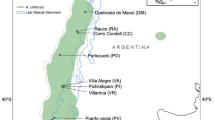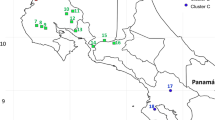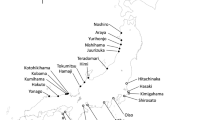Abstract
Corylus mandshurica Maxim. belongs to the family Betulaceae and is an important economically and ecologically tree in China. Wild Corylus mandshurica resources have been gradually destroyed recently. Thus, investigation into the genetic diversity and genetic differentiation is indispensable for the efficient protection and breeding of Corylus mandshurica resources. A total of 347 individuals collected from 12 natural populations were investigated using amplified fragment length polymorphism markers. All 12 Corylus mandshurica populations showed various degrees of genetic diversity, with the value for the Mudanjiang, Heilongjiang Province population reflecting maximum genetic diversity. A UPGMA dendrogram was classified into two main clusters (Cluster I and Cluster II). Moreover, STRUCTURE analysis showed that the result of the divisions at K = 2 was highly related to the UPGMA dendrogram and PCoA scatter plot. The results of both FST and AMOVA suggested that there was low genetic differentiation among different populations. The high level of gene flow among populations can effectively prevent genetic drift. BARRIER analysis indicated that the first barrier boundary located between Cluster I and Cluster II was probably caused by the Yanshan Mountains. Our study provides valuable information for Corylus mandshurica conservation and breeding in the future.










Similar content being viewed by others
References
Amat ME, Silvertown J, Vargas P (2013) Strong spatial genetic structure reduces reproductive success in the critically endangered plant genus Pseudomisopates. J Hered 104:692–703
Campbell D, Duchesne P, Bernatchez L (2003) AFLP utility for population assignment studies: analytical investigation and empirical comparison with microsatellites. Mol Ecol 12:1979–1991
Demirbaş Ö, Karadağ A (2015) Biosorption of zinc ions onto Corylus avellana L. Desalin Water Treat 53:2692–2700
Di XY, Liu KW, Hou SQ, Ji PL, Wang YL (2014) Genetic variation of hazel (Corylus heterophylla) populations at different altitudes in Xingtangsi forest park in Huoshan, Shanxi, China. Plant Omics 7:213–220
Doyle J (1987) A rapid DNA isolation procedure for small quantities of fresh leaf tissue. Phytochem Bull 19:11–15
Eckert CG, Lui K, Bronson K, Corradini P, Bruneau A (2003) Population genetic consequences of extreme variation in sexual and clonal reproduction in an aquatic plant. Mol Ecol 12:331–344
Ennos RA (1994) Estimating the relative rates of pollen and seed migration among plant populations. Heredity 72:250–259
Erdemir US, Gucer S (2015) Bioaccessibility of copper in Turkish hazelnuts (Corylus avellana L.) by chemical fractionation and in vitro methods. Biol Trace Elem Res 167:146–154
Erdogan V, Koksal AI, Aygun A (2010) Assessment of genetic relationships among Turkish hazelnut (Corylus avellana L.) cultivars by RAPD markers. Rom Biotech Lett 15:5591–5601
Evanno G, Regnaut S, Goudet J (2005) Detecting the number of clusters of individuals using the software STRUCTURE: a simulation study. Mol Ecol 14:2611–2620
Ferreira JJ, García C, Tous J, Rovira M, Varvaro L, Franco S (2009) Structure and genetic diversity of local hazelnut collected in Asturias (Northern Spain) revealed by ISSR markers. Acta Hort 845:163–168
Gerber S, Chadœuf J, Gugerli F, Lascoux M, Buiteveld J, Cottrell J, Dounavi A, Fineschi S, Forrest JJ, Fogelqvist J et al (2014) High rates of gene flow by pollen and seed in oak populations across Europe. PLoS ONE 9:e85130
Gitzendanner MA, Soltis PS (2000) Patterns of genetic variation in rare and widespread plant congeners. Am J Bot 87:783–792
Gradishar WJ (2012) Taxanes for the treatment of metastatic breast cancer. Breast Cancer Basic Clin Res 6:159–171
Hamrick JL, Godt MJW, Sherman-Broyles SL (1992) Factors influencing levels of genetic diversity in woody plant species. N Forest 6:95–124
Hardy OJ, Vekemans X (2002) Spagedi a versatile computer program to analyse spatial genetic structure at the individual or population levels. Mol Ecol Resour 2:618–620
Ji A, Wang Y, Wu G, Wu W, Yang H, Wang Q (2014) Genetic diversity and population structure of north china mountain walnut revealed by ISSR. Am J Plant Sci 5:3194–3202
Keim P, Schupp JM, Travis SE, Clayton K, Zhu T, Shi L, Ferreira A, Webb DM (1997) A high-density soybean genetic map based on AFLP markers. Crop Sci 37:537–543
Kuang KR, Zheng SX, Li PQ, Lu AM (1979) Flora of China. Science Press, Beijing
Kumar S, Mahdi H, Bryant C, Shah JP, Garg G, Munkarah A (2010) Clinical trials and progress with paclitaxel in ovarian cancer. Int J Womens Health 2:411–427
Leinemann L, Steiner W, Hosius B, Kuchma O, Arenhövel W, Fussi B, Kätzel R, Rogge M, Finkeldey R (2013) Genetic variation of chloroplast and nuclear markers in natural populations of hazelnut (Corylus avellana L.) in Germany. Plant Syst Evol 299:369–378
Li M, Zhao Z, Miao XJ, Zhou JJ (2014) Genetic diversity and population structure of Siberian apricot (Prunus sibirica L.) in China. Int J Mol Sci 15:377–400
Liu H, Liu G, Li G, Han C (2013) Analysis on properties of woody diesel plants Corylus mandshurica Maxim. et Rupr. J Chin Cereal Oil Assoc 28:41–45
Ma ZQ (2001) Shanxi vegetation. Science and Technology Press, Beijing
Manni F, Guérard E, Heyer E (2004) Geographic patterns of (genetic, morphologic, linguistic) variation: how barriers can be detected by using monmonier’s algorithm. Hum Biol 76:173–190
Ohsawa T, Saito Y, Sawada H, Ide Y (2008) Impact of altitude and topography on the genetic diversity of quercus serratapopulations in the Chichibu Mountains, central Japan. Flora 203:187–196
Papadopulos AST, Baker WJ, Crayn D, Butlin RK, Kynast RG, Hutton I, Savolainen V (2011) Speciation with gene flow on Lord Howe Island. PNAS 108:13188–13193
Peakall R, Smouse PE (2012) GenAlEx 6.5: genetic analysis in Excel. Population genetic software for teaching and research-an update. Bioinformatics 28:2537–2539
Petit RJ, Duminil J, Fineschi S, Hampe A, Salvini D, Vendramin GG (2005) Comparative organization of chloroplast, mitochondrial and nuclear diversity in plant populations. Mol Ecol 14:689–701
Plosker GL, Hurst M (2001) Paclitaxel: a pharmacoeconomic review of its use in non-small cell lung cancer. Pharmacoeconomics 19:1111–1134
Pritchard JK, Stephens M, Donnelly P (2000) Inference of population structure using multilocus genotype data. Genetics 155:945–959
Sathuvalli VR, Chen H, Mehlenbacher SA, Smith DC (2011) DNA markers linked to eastern filbert blight resistance in “Ratoli” hazelnut. (Corylus avellana L.). Tree Genet Genomes 7:337–345
Schaal BA, Hayworth DA, Olsen KM, Rauscher JT, Smith WA (1998) Phylogeographic studies in plants: problems and prospects. Mol Ecol 7:465–474
Schenk MF, Thienpont CN, Koopman WJM, Gilissen LJWJ, Smulders MJM (2008) Phylogenetic relationships in betula (Betulaceae) based on AFLP markers. Tree Genet Genomes 4:911–924
Slatkin M (1985) Rare alleles as indicators of gene flow. Evolution 39:53–65
Soltis PS, Soltis DE, Tucker TL, Lang FA (1992) Allozyme variability is absent in the narrow endemic Bensoniella oregona (Saxifragaceae). Conserv Biol 6:131–134
Stevens VM, Turlure C, Baguette M (2010) A meta-analysis of dispersal in butterflies. Biol Rev 85:625–642
Tamura K, Peterson D, Peterson N, Stecher G, Nei M, Kumar S (2011) MEGA5: molecular evolutionary genetics analysis using maximum likelihood, evolutionary distance, and maximum parsimony methods. Mol Biol Evol 28:2731–2739
Vos P, Hogers R, Bleeker M, Reijans M, Lee TVD, Hornes M, Frijters A, Pot J, Peleman J, Kuiper M (1995) AFLP: a new technique for DNA fingerprinting. Nucleic Acids Res 23:4407–4414
Wang DW, Li Y, Li ZQ (2011) Identification of a male-specific amplified fragment length polymorphism (AFLP) and a sequence characterized amplified region (SCAR) marker in Eucommia ulmoides Oliv. Int J Mol Sci 12:857–864
Wang H, Pan G, Ma Q, Zhang J, Pei D (2015) The genetic diversity and introgression of Juglans regia and Juglans sigillata in Tibet as revealed by SSR markers. Tree Genet Genomes 11:1–11
Whitcher IN, Wen J (2001) Phylogeny and biogeography of corylus (Betulaceae): inferences from ITS sequences. Syst Bot 26:283–298
Whitlock MC, Mccauley DE (1999) Indirect measures of gene flow and migration: F ST not equal to 1/(4Nm + 1). Heredity 82:117–125
Yi X, Zhang Z (2008) Seed predation and dispersal of glabrous filbert (Corylus heterophylla) and pilose filbert (Corylus mandshurica) by small mammals in a temperate forest, northeast China. Plant Ecol 196:135–142
Zeinalabedini M, Dezhampour J, Majidian P, Khakzad M, Zanjani B, Soleimani A, Farsi M (2014) Molecular variability and genetic relationship and structure of Iranian Prunus rootstocks revealed by SSR and AFLP markers. Sci Hortic-amsterdam 172:258–264
Zhang YH, Liu L, Liang WJ, Zhang YM (2005) The cultivated techniques of hazelnut in China fruits monograph: chestnut and hazelnut volume. China Forestry Publishing Press, Beijing
Zhang C, Vornam B, Volmer K, Prinz K, Kleemann F, Köhler L, Polle A, Finkeldey R (2015) Genetic diversity in aspen and its relation to arthropod abundance. Front Plant Sci 5:806
Zong JW, Zhao TT, Ma QH, Liang LS, Wang GX (2015) Assessment of genetic diversity and population genetic Structure of corylus mandshurica in China using SSR Markers. PLoS ONE 10:e0137528
Acknowledgements
This study was funded by the National Natural Science Foundation of China (Grant No. 31500555), the Special Fund for Basic Scientific Research Business of Central Public Research Institutes (Grant No. CAFYBB2016QB003 and CAFYBB2017ZA004-9).
Author information
Authors and Affiliations
Contributions
TZ and LW conceived and designed the experiments. ZY and TZ performed the experiments. ZY and TZ analyzed the data. TZ, LW, and ZY contributed materials/analysis tools. ZY and TZ wrote the paper. TZ, LW, and ZY prepared the figures and/or tables. TZ reviewed drafts of the paper.
Corresponding author
Rights and permissions
About this article
Cite this article
Yang, Z., Wang, L. & Zhao, T. High genetic variability and complex population structure of the native Chinese hazelnut. Braz. J. Bot 41, 687–697 (2018). https://doi.org/10.1007/s40415-018-0466-8
Received:
Accepted:
Published:
Issue Date:
DOI: https://doi.org/10.1007/s40415-018-0466-8




